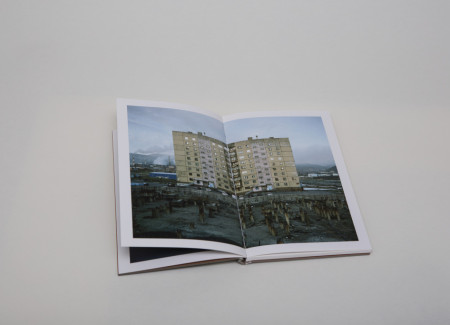JTF (just the facts): Published by The Velvet Cell in 2015 (here). Hardcover, 64 pages, with 28 color photographs. In an edition of 500 copies. There are no texts or essays. (Cover and spread shots below.)
Comments/Context: In the past decade, a new generation of photographers documenting the diverse realities of post-Soviet Russia has emerged. The work of Evgenia Arbugaeva, Igor Samolet, Olya Ivanova, Alexey Bogolepov, and Sasha Rudensky (just to name few) has shown the country and its residents in fundamentally new ways, from youth subculture and the bustle of major cities to the details of everyday life in isolated villages. Seen together, the images are profoundly affecting the way we see and perceive the new Russia.
Alexander Gronsky was born in Estonia and spent a large part of his life in Russia. A self-taught photographer, he started his career in the press; today Gronsky works on his personal projects and considers himself a landscape photographer. His images center on geography and the way it impacts the local population, its living conditions, and its overall mentality. Gronsky often turns his camera to post-Soviet landscapes, capturing them in their desolate urban beauty: the untidiness of Moscow’s suburbs, eerie Murmansk during the months long night, and the wild Siberian North.
In 2013, Gronsky photographed Norilsk (a city in the north of Siberia with the population of 170,000 people) and this body of work has been recently published as a photobook by The Velvet Cell. Sadly, Norilsk is one of the most polluted places on the planet. Built by gulag prisoners in the 1930s, Norilsk stands on the largest nickel deposits on Earth; not surprisingly, it is a massive mining and metallurgical complex, bringing in 2 percent of Russia’s national GDP. The city is entirely isolated from the mainland: there are no roads and no railways, making it only accessible by air (and in certain months by water).
Life in Norilsk is undeniably harsh. The winters are extremely cold and it is grey most of the year. Seven long weeks of polar days and nights contribute to the residents’ anxiety and depressed emotional well-being. There are no living trees within 30 miles of the city. Due to industrial pollution and harsh living conditions, the average life expectancy of the workers is at least ten years shorter than the country’s average. A high percentage of residents moved to Norilsk for the money, but once they are there, it’s not easy to leave.
Gronsky takes a formalistic approach to the study of Norilsk. Using a large format camera, he has photographed the bleak reality of the over-industrialized city with a distinct aesthetic, using receding perspective lines to draw us into his scenes. Shabby panel block apartment buildings and wastelands constitute the city’s architectural landscape. One of the first images in the book shows a tall residential building as it stands in the decaying environment, with the remnants of unfinished metal structures in front and a tangle of factory pipes in the background. Another image captures a lifeless playground located between a crowd of ugly heavy apartment buildings.
Gronsky’s cities often look empty and abandoned, and Norilsk is no exception. There are almost no people in these photographs, and those few we do see look rather lost (it is likely that the photographs were taken in the summer during white nights). One picture captures two men at a the crossroads waiting for a bus; they seem dwarfed by the gigantic apartment blocks towering around them and somehow there is a feeling that the bus will never arrive. Another photo captures a woman as she walks down the road, crossing a railway. A third finds three men rowing a makeshift raft across a polluted waterway surrounded by trash heaps. These few lonely figures only reinforce our perception of Norilsk as a ghost town. As we flip through the book, there are images of endless electric towers, belching smokestacks, empty streets, neglected metal car carcasses, and landscapes altered the industry. The only place that looks alive is an abandoned cemetery: green bushes and grass are taking over felled monuments and destroyed metal fences around the graves. There is only one building that stands out of this grey square post-apocalyptic mass – it is the Nurd Kamal mosque, with its distinct turquoise walls and golden roof.
Gronsky’s photographs depict quite a depressing reality. Yet the photographer’s talent for well measured composition and his choice of a muted, predominantly grey color palette (with a few bright interventions here and there), adds an almost romantic feeling to the dull experience. Each photograph merits a closer look, as the details come to life with further inspection. The photobook’s small size encourages this kind of hand held engagement. Its diminutive size plays with the large format of the photographs, and while the book is vertical, all the images are horizontal, pulling each photograph across a spread (each with a small white border). The book opens flat, ensuring a pleasant interaction with the visual flow.
Norilsk is an elegantly simple photobook. Gronsky’s portrait of this industrial wasteland brings surprising sensitivity to the disturbingly monstrous Soviet architecture. His Norilsk straddles the border between harsh industrial reality and unlikely idyllic beauty. It makes us take another look at this forgotten town, appreciating how the art of photography can transform the mundane into the special.
Collector’s POV: Alexander Gronsky is represented by Polka Galerie in Paris (here) and Yuka Tsuruno Gallery in Tokyo (here). His work has little secondary market history at this point, gallery retail remains the best option for those collectors interested in following up.
















